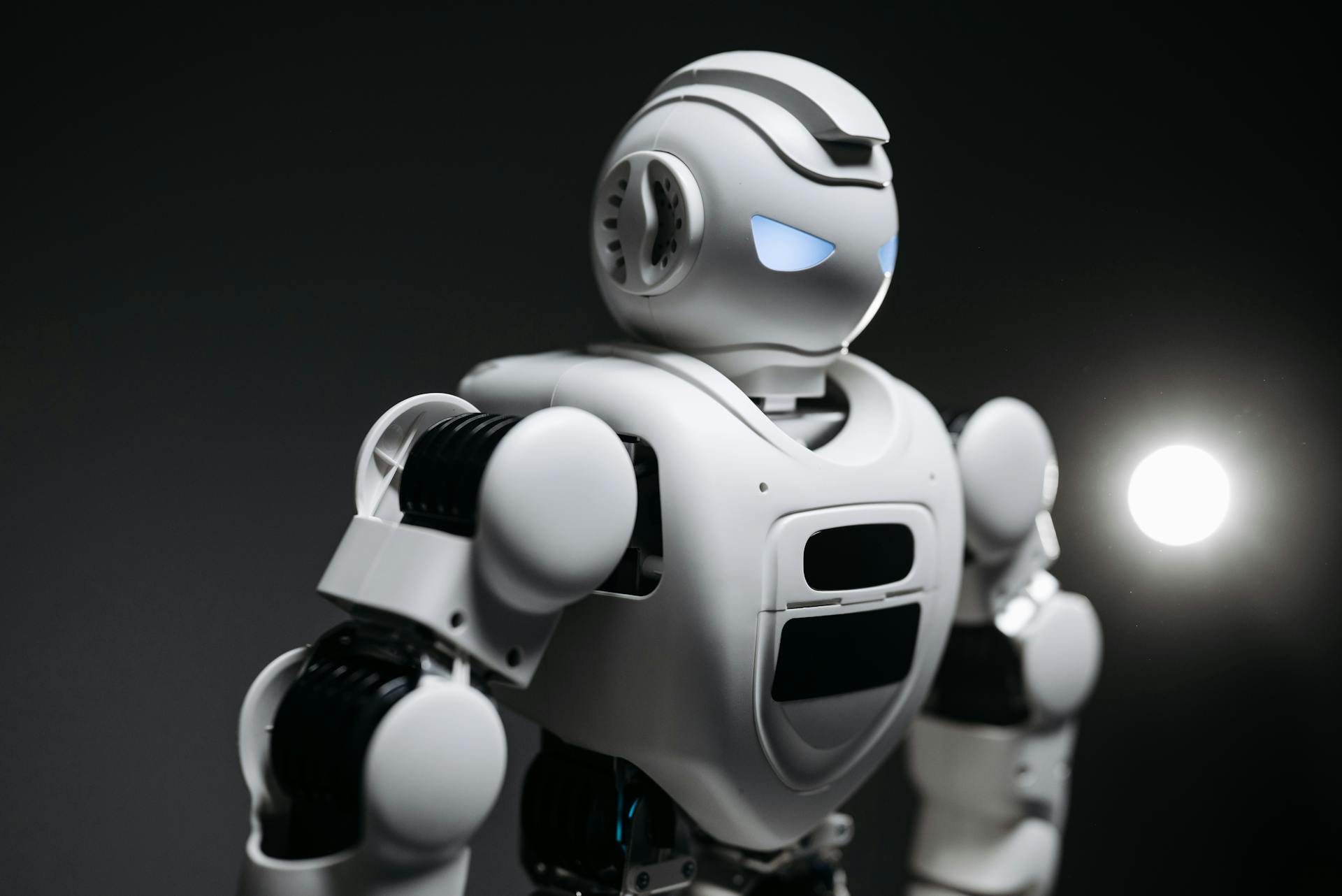
Perception in artificial intelligence is a complex process that allows machines to interpret and understand their surroundings. It's a crucial aspect of AI, enabling robots to navigate and interact with their environment.
Perception involves multiple senses, including vision, hearing, and touch. In the field of computer vision, for instance, algorithms are designed to recognize patterns and objects in images.
A key challenge in perception is dealing with noise and ambiguity in sensor data. This is evident in the case of image classification, where small variations in lighting or image quality can significantly impact accuracy.
To overcome these challenges, researchers have developed techniques such as machine learning and deep learning. These methods enable AI systems to learn from large datasets and improve their performance over time.
You might enjoy: Artificial Intelligence and the Future of Teaching and Learning
Machine Vision
Machine vision is a field that includes methods for acquiring, processing, analyzing, and understanding images and high-dimensional data from the real world to produce numerical or symbolic information, e.g., in the forms of decisions.
Computer vision has many applications already in use today such as facial recognition, geographical modeling, and even aesthetic judgment. These applications rely on the ability of machines to interpret visual input accurately, which can be a challenge.
Machines still struggle to interpret visual input accurately if said input is blurry, and if the viewpoint at which stimulus are viewed varies often. Computers also struggle to determine the proper nature of some stimulus if overlapped by or seamlessly touching another stimulus, a phenomenon known as The Principle of Good Continuation.
Machines also struggle to perceive and record stimulus functioning according to the Apparent Movement principle, which Gestalt psychologists researched.
Here are some key challenges in machine vision:
- Blurry images: Machines have difficulty interpreting images that are blurry or of poor quality.
- Variable viewpoints: Machines struggle to interpret images that are taken from different angles or viewpoints.
- Overlapping stimuli: Machines have difficulty determining the proper nature of stimuli that are overlapped or touching each other.
These challenges highlight the complexity of machine vision and the need for continued research and development in this area.
Machine Perception
Machine perception is a crucial aspect of artificial intelligence, enabling machines to interpret and understand the world around them. Computer vision, a key area of machine perception, allows machines to acquire, process, and analyze images and data from the real world.
For another approach, see: Intelligent Harmony Machine
Machines still struggle to interpret blurry images or those viewed from varying viewpoints. Facial recognition, geographical modeling, and aesthetic judgment are just a few areas where computer vision is already being used.
Machine hearing, or machine listening, is another important area of machine perception. This technology enables machines to take in and process sound data, such as speech or music, and even replicate the human brain's ability to selectively focus on specific sounds.
Machine hearing has many practical applications, including music recording and compression, speech synthesis, and speech recognition. Many devices, like smartphones and voice translators, rely on machine hearing.
Despite its advancements, machine hearing still struggles with speech segmentation, particularly when human accents are involved. This makes it challenging for machines to accurately hear words within sentences.
Machine touch is another area of machine perception where machines process tactile information. This enables intelligent reflexes and interaction with the environment, such as measuring friction and surface properties.
However, machines still lack the ability to measure physical human experiences like pain. Scientists have yet to invent a mechanical substitute for the Nociceptors in the body and brain that detect and measure physical discomfort and suffering.
You might like: Machine Intelligent
Autonomous Systems
Autonomous systems rely heavily on visual perception to navigate their environment. This involves using cameras and sensors to capture high-resolution images and videos.
The data collected from these cameras and sensors is then preprocessed to adjust for variations in lighting and weather conditions. This ensures that the images are clear and uniform, allowing the system to accurately extract features.
Features such as traffic signals, vehicles, and pedestrians are extracted from the preprocessed image. These features are then classified and labeled using deep learning models, particularly convolutional neural networks (CNNs).
The system uses these recognized elements to comprehend the scene holistically. It understands the relationships between objects, such as a red traffic light and a pedestrian crossing the street.
The vehicle's AI predicts the actions of these elements, estimating whether the pedestrian will continue to cross or stop. This allows the system to make decisions in real-time, such as slowing down and stopping at the intersection.
The vehicle executes its decision by engaging the brakes smoothly and waiting for the pedestrian to cross and the light to turn green. This process happens rapidly, allowing the vehicle to navigate complex environments safely and efficiently.
Perception in AI
Perception in AI is a complex process that involves analyzing data from various sources, including sensors, cameras, and microphones. Machines can interpret sensory data for decisions, just like humans do.
However, AI still struggles with certain aspects of visual perception, such as interpreting blurry images and understanding the Principle of Good Continuation. This principle refers to the difficulty of determining the proper nature of a stimulus when it's overlapped by or seamlessly touching another stimulus.
AI systems can learn from vast datasets and adapt to incoming data, similar to human learning and adaptation. But they lack the depth inherent in human perception, which is actively explored and shaped by our senses.
Here's a comparison of AI senses and human senses:
- AI Senses: Employ sensors, cameras, and microphones to understand surroundings.
- Human Senses: Utilize sight, hearing, touch, taste, and smell to understand surroundings.
- AI Senses: Learn from vast datasets and adapt to incoming data.
- Human Senses: Our ability to learn and adapt is a fundamental aspect of human perception.
This comparison highlights the differences between AI and human senses, but also shows how AI can simulate human perception by recognizing objects, comprehending speech, and interpreting visual and auditory signals.
Machine Olfaction
Machine olfaction is a field where scientists are developing computers that can recognize and measure smells.
These computers, sometimes called electronic noses, can sense airborne chemicals and classify them.
This technology has the potential to revolutionize industries such as food safety and quality control.
By detecting subtle changes in scents, machine olfaction can help identify spoiled or contaminated products.
This could lead to safer and healthier food options for consumers.
Concepts for Beginners
Perception in AI is a complex mechanism that allows machines to understand their surroundings by analyzing data from sensors, cameras, and microphones.
To grasp this concept, let's break it down into its fundamental components. Visual perception is a key aspect of AI, which involves analyzing visual stimuli like pictures and videos to comprehend the environment.
Visual perception in AI is a mechanism that derives information from visual data, similar to how humans do. It's a complex interplay of sensory input, cognitive processing, and contextual understanding.
AI systems learn and adapt to their environment through machine learning, deep learning, and sensory data processing. This enables them to recognize objects, comprehend speech, and interpret visual and auditory signals.
The relationship between AI senses and human senses is fascinating. AI systems employ sensors, cameras, and microphones, similar to human senses, to understand their surroundings.
Here's a comparison of AI senses and human senses:
While AI excels in data processing, it lacks the depth inherent in human perception, making understanding these dynamics crucial for AI-human collaboration.
Evaluating Multimodal Systems
Evaluating multimodal systems is a crucial step in understanding their capabilities and limitations. We can use the Perception Test to evaluate these systems, which includes a small fine-tuning set and a public validation split.
The Perception Test is designed to assess the abilities of models across six computational tasks, including visual question-answering and object tracking. The test includes a held-out test split where performance can only be evaluated via an evaluation server.
The evaluation results are detailed across several dimensions, providing a comprehensive assessment of the model's skills. An ideal model would maximize the scores across all radar plots and dimensions.
To ensure diversity in the evaluation, the benchmark includes participants from different countries, ethnicities, and genders, and aims to have diverse representation within each type of video script.
Understanding the Test
The Perception Test is a comprehensive evaluation framework for multimodal systems, designed to assess their ability to perceive and understand the world.
The test includes a small fine-tuning set that model creators can use to convey task information, while the remaining 80% of the data is split into public validation and held-out test sets.
Inputs to the test include video and audio sequences, plus a task specification that can be in high-level text form or low-level input like object coordinates.
The evaluation results are detailed across several dimensions, measuring abilities across six computational tasks, including visual question-answering.
For visual question-answering tasks, the test provides a mapping of questions across types of situations and reasoning required to answer them.
An ideal model would maximise scores across all radar plots and dimensions, providing a detailed assessment of the model's skills.
The test also includes a multi-dimensional diagnostic report that breaks down performance by computational task, area, and reasoning type.
Diversity of participants and scenes in the videos was a critical consideration, with participants selected from different countries, ethnicities, and genders.
The test is publicly available, and a leaderboard and challenge server will be available soon, allowing researchers to compare and improve their models.
Sources
- https://en.wikipedia.org/wiki/Machine_perception
- https://indiaai.gov.in/article/understanding-the-significance-of-perception-in-ai
- https://www.geeksforgeeks.org/what-is-visual-perception-in-ai/
- https://cielarose.medium.com/learnings-at-the-edge-72c9ea950f1f
- https://deepmind.google/discover/blog/measuring-perception-in-ai-models/
Featured Images: pexels.com


